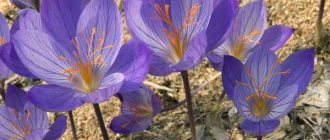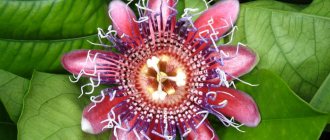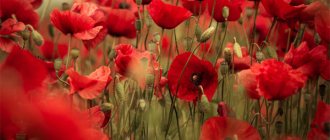The fern flower is a mythical flower that reveals to its owner the treasures and secrets of the world, giving clairvoyance and strength to the unclean spirit.
According to Slavic beliefs, the fern blooms only for one moment, on the night before Ivan Kupala (June 24 [July 7]).
It is very difficult to pick a flower, especially since evil spirits hinder and intimidate a person in every possible way, in some cases depriving him of his mind, speech, and memory.
In fact, the fern cannot bloom. Refers to fern plants that reproduce by spores.
Description of the plant
Photo:
Fern is a herbaceous plant belonging to the Osmundaceae family, the fern family. The plant's homeland is Northern China, Korea, and the Russian Far East.
Distributed in Russia, Ukraine, Finland, and Central Asia. It is a green stem with numerous pinnately dissected leaves. The fern reproduces only through spores and does not bloom.
Interesting. Fern is one of the oldest plants on the planet, appearing in the Devonian period of the Paleozoic era. Later, the wood from the plant became a source of coal.
It is believed that this plant is a descendant of the first plants on the planet - rhinophytes. Their branches gradually turned into leaves as the spores moved from the ends of the branches to the underside of the leaf.
The process of spore emergence and maturation is very similar to the growth of flowers. The plant is harvested throughout the summer.
Today there are thousands of species of ferns.
Structure, flowering
The stem of the fern is smooth and has no scales. The root system is powerful. The root belongs to the vine; buds are formed on it, from which young shoots are formed.
The stepchildren emerge from the ground at a distance of 10-20 cm and first have a snail-shaped head, which gradually turns into leaves.
Sporulation is the main method of reproduction of ferns. The spores grow on the underside of the leaf. As the spore capsule matures, it disintegrates and the spores scatter in the wind.
As soon as they land on fertile soil, they begin to grow.
As the spore grows, a growth forms in the form of a small green cup. Sperm and eggs appear on the back of the growth.
After fertilization of the egg, seed germination begins and the stepson begins to take root. The fern forms a bush for several years. Fern blossoms are impossible.
Vegetative propagation of fern is possible. In this case, long arrows form on the bush. They bend over to the kidney and press themselves against the stone.
Such human reproduction is carried out in the garden or at the dacha. The arrow takes root in the ground. For replanting, a plot of land is dug up along with the root system.
Ferns also reproduce by division. In early spring it must be removed from the ground. Dense roots are washed off the soil with water, divided into shoots, which are then transplanted to another area.
What are called leaves in everyday life are called fronds in science. They are capable of continuously increasing in length. Fronds actively participate in photosynthesis and plant reproduction.
The bark of the stems acts as a support. Ferns are unchanged, so they are fragile. Compared to angiosperms, their conductive tissues are much weaker.
The structure of the fern is very different, depending on the species. There are low herbaceous plants, and there are large ferns that resemble trees.
Some ferns reach a height of up to 20 m. In addition, branched and fairly strong adventitious roots are formed on the tree trunk.
The Legend of the Fern Flower
Since ancient times, a beautiful story has come down to us, the main character of which was Semargl, who guarded the sun and was the brother of Perun. One day he fell in love with the Swimsuit, the gentle goddess of the night, who seemed very inaccessible, but she responded to the young man’s feelings. The problem was that Semargl had to constantly be on his solar throne, and the Swimsuit was the ruler of the night.
The lovers could not resist their feelings, and on June 21 (old style) they merged together, and this day was recognized as the summer equinox. After some time, the couple had two children, who were named Kostroma and Kupala. Perun decided to give a gift to his brother and in honor of the birth of his nephews, he presented them with a fern flower for good luck, which had enormous power.
Belief
Fern flower on the Belarusian commemorative coin “Kupala”
Picking a fern flower and keeping it with you opens up unusual possibilities.
Become perceptive, be able to understand the language of animals, see all the treasures, no matter how deep they are in the ground.
To enter the treasure without hindrance, attaching a flower to the curls and curls - they will crumble in front of him, take possession of unclean spirits, control the earth and water, become invisible and take on any form.
According to legend, a flower bud from a fern bush is shown at midnight. Then it moves back and forth, then sways like a river wave, then jumps like a living bird.
All this happens because evil spirits are trying to hide an expensive color from the human eye. Then every minute it grows and grows upward, blooming like a hot coal.
Finally, at exactly 12 o’clock, the color opens with a crack like lightning, and with its flame it lights up nearby and far away.”
To collect a fern, on the night of Ivan Kupala, you need to spread a sacred tablecloth (used during the bright week) near the plant, draw a circle around you with a blessed knife, read the spell and wait until midnight.
Evil spirits are trying to distract the hunter for the fern flower - they make noise, call the voice of a loved one and scream. If you answer the voice or speak to the ghost, you may lose a life.
The evil spirit tears off his head instead of a fern and sends his soul to hell in torment because he dared to steal the flower that decorates hell.
Having picked up the flower, you need to hide it in your chest and run without looking back (according to another belief, you need to carefully place it on your open palm and take it home without looking back).
Belarusian legends
According to Belarusian belief, on Kupala night you had to go out into the forest alone, without a flashlight, without a flashlight (according to some legends, even barefoot or without clothes).
It was necessary to enter such a forest jungle from which you could not even hear the roosters or dogs of your native village. The fern flower is believed to glow in the dark.
I had to injure my palm, hold a flower in my palm and go home. The evil spirit will make noise, growl, scare, but will not look back.
Having received a fern flower, a person will acquire the ability to see what is invisible to others, he will become wise.
It happened that a cross was drawn above the flower, which meant a secret treasure, and below was a rooster, which symbolized the north.
Carpathian analogue
In the Carpathians there was a similar legend about the red rue flower, which usually blooms yellow. This legend is sung in the song “Chervona Ruta”.
According to one version, rue chervona is an ordinary fragrant rue plant, the yellow flowers of which miraculously turned red. It was as if it happened once a year, on the night of Ivan Kupala, and for a very short time.
A girl who manages to pull out the red color of the rue before it turns yellow again will be able to “bewitch” any boy for life.
How does a fairy tale legend describe the flowering of fern?
A legend has been passed down from mouth to mouth since ancient times that not every forest can contain a blooming fern. It can only grow in a completely wild thicket far from places where people live. In such a forest, under the canopy of centuries-old trees, there is a clearing overgrown with a huge number of ferns, but only one bush can bloom, and at night. If a girl finds such a bush around midnight, she will probably see a bright bud begin to grow from its middle right before her eyes.
In just a few minutes, the bud grows into a tall peduncle with a bud at the top. Exactly at midnight, this bud opens and the girl sees a bright huge flower in front of her, which, moreover, with its glow illuminates the entire clearing and the trees standing around.
In literature
The fern flower is found in folk tales, legends and songs.
A number of writers and poets have encountered the legend:
- Nikolai Vasilyevich Gogol (story “The Evening on the Eve of Ivan Kupala”);
- Józef Kraszewski (Fern Flower);
- Vincent Dunin-Martsinkevich, Yanka Kupala (“Kupala Night, Kurgan”);
- Yakub Kolas (“The Night When the Fern Blooms”);
- Mikhas Charot (Su Kupala");
- Frantisek Alekhnovich (children's play “Fern Flower”, 1916),
- Constance Billeaud (fern flower);
- Vladimir Korotkevich (“That Night”, reading “The Cradle of Four Witches”).
Preparing Edible Fern
Bracken is a healthy and tasty plant that is widely used in oriental cuisine. You can use it to prepare salads, soups, appetizers, stews and fried dishes. Young fern shoots go well with rice, noodles, vegetables, meat and seafood. Bracken has a positive effect on the digestion process, is rich in vitamins, and its calorie content is quite low - 34 kcal.
Interesting! Fried fern is especially popular - this method of cooking helps preserve the taste and crispness of the shoot.
Recipes with fried fern
Almost all recipes can be prepared with fresh, frozen, dried and salted fern. You just need to take into account some nuances: it is recommended to soak dried pagons in warm water for several hours, salted ones must be thoroughly rinsed.
With onion
Cut 2 medium onions into half rings, fry in vegetable oil until golden brown, add 500 g of boiled fern, cut into small pieces, into the frying pan, fry for several minutes. This is a simple but delicious dish. If desired, you can add carrots, season with sour cream and mayonnaise. If you season it with soy sauce, you get Korean fern.
Fern dishes
With potato
300 g of boiled sprouts should be fried until crispy and placed on a plate. Place 500 grams of potatoes, cut into long pieces, into a frying pan and fry until tender. Salt, pepper, add prepared fern. If desired, you can add onions and garlic. The potatoes acquire a delicious mushroom aroma.
With meat
The meat is cut into thin slices, marinated with salt, pepper, and soy sauce. The onion is cut into half rings, fried in vegetable oil, and placed on a plate. The meat is placed in a frying pan, fried until the skin is golden brown, and cooked until half cooked.
With meat
The prepared shoots are placed with the meat, and onions are added. If desired, you can finish the dish with sour cream or soy sauce, add sesame seeds.
If the fern is bitter
In the process of preparing rachis, you may encounter a common problem - the fern becomes bitter, radically changing the taste of the dish. How to easily remove bitterness from fern? It’s very simple: soak the shoots in salted water for several hours, change the water a couple of times.
Then rinse the pagons well and boil them for 6-9 minutes with the addition of salt. Such sprouts are ready for consumption or further preparation and storage.
The bracken fern is not only a beautiful plant. It can be grown at home, or used to decorate an alpine hill or a corner in the garden. In addition, the culture is valued for its beneficial properties and is used in medicine. Bracken is an edible fern; delicious dishes are prepared from it, fried, pickled, and stored for the winter.
Interesting properties
This plant is believed to have magical properties.
From time immemorial it has been used not only for magical rituals, but also for the treatment of many diseases:
- With the help of a flower obtained at midnight in front of Ivan Kupala, you can find treasures.
- To attract the groom, the girl weaves a branch of fern into her braids and wears it like that.
- To get rid of sciatica pain, you need to cover the mattress with fern leaves and branches. Medicine says that pain and inflammation will quickly pass.
- The root of this plant is used in magic against the evil eye. To do this, the crushed part of the root is added to various potions. Anyone who drinks this decoction will get rid of diseases caused by the “evil eye.” It can protect you from diseases. The root helps with love spells and flaps, and removes the effect of any ritual with which a person does not agree.
- If you place a whole fern root on the house, it will protect the inhabitants of the house from negative energy. A sorcerer and anyone with bad intentions cannot enter such a mansion.
- To use fern as a reliable remedy for the evil eye, you should wear it as close to your body as possible. To do this, the fern is dug up at dawn, washed, and left to dry in the sun. It must be applied the next day.
- The root is used by gypsies. The plant helps maintain clarity of thought and will not allow a person to deceive himself when communicating with it.
Some people use fern for pickling. Products prepared with the addition of fern to the brine have a very interesting taste.
Types of fern
There are many varieties of this plant, but there are those that are especially popular among gardeners. For beginner gardeners, we can recommend nephrolepis ferns. They do not require too much care, are unpretentious and feel great indoors. This flower has openwork leaves containing spores inside. The leaves of the plant form a very beautiful rosette and reach a size of 45-50 centimeters. There are no less beautiful fern flowers.
For example, asplenium or ossicle. It has continuous, undivided leaves that are very sensitive to touch. Platycerium is another plant variety that is distinguished by the shape of its leaves. The fern is similar to a head of cabbage, from which flat leaves grow that resemble the antlers of a deer. Davallia is a flower with fuzzy, red rhizomes that hang from pots. This fern has beautiful lush green leaves, the distinctive feature of which is its rapid growth. This plant is popularly called “hare’s foot.”
Image of the amulet Fern Flower (Perunov color)
Externally, the “Perunov Color” sign has a pronounced swastika structure. Swastika signs for the ancient Slavs were always sacred and were also called solar - that is, those that are subordinate to the Sun or His movement. Swastika signs have always denoted and still denote the movement in a spiral, the movement of galaxies in the Universe. Those four rays that emanate from the center of the sign are curved and have “shoots”. All together they create the bizarre outlines of a labyrinth in the four cardinal directions. The design of the symbol is such that it does not imply closure - the ends of the rays can be completed, continued indefinitely, creating a salt-and-pepper rotation - clockwise or in the direction of the Sun.
The color of fern is only one of the amulets with the power of Perun - the Thunderer. You can see other amulets on the page Perunov sign, symbol: action, who is suitable.
Fern blossom
From a botanical point of view, a fern never blooms - it reproduces by spores.
A. B. Strakhov compared the beliefs about the fern flower with European folk legends about the flowering and fruiting of trees on Christmas night. He came to the conclusion that all such ideas do not have any “pagan” background and represent a popular reinterpretation of the biblical comparison of the Mother of God (who conceived and gave birth, remaining a virgin) with the blossoming rod of Aaron.
- Stamp of Ukraine with the legendary fern flower. 1997
- Blooming Aaron's rod. German miniature, XV century.
- A “fertile leaf” that looks like a fern flower, but is not one.
Humidity and temperature
Like all plants, ferns need a certain temperature and air humidity. In an apartment, breeding conditions do not always meet the requirements of the flower. Fern loves high humidity, so it must be constantly sprayed, especially in summer. The optimal temperature for keeping a flower is 20 degrees. This plant is very sensitive to changes in heat and cold. To make the plant feel more comfortable, you need to lay a layer of pebbles on top of the soil, which will maintain the level of humidity and temperature of the pot.











